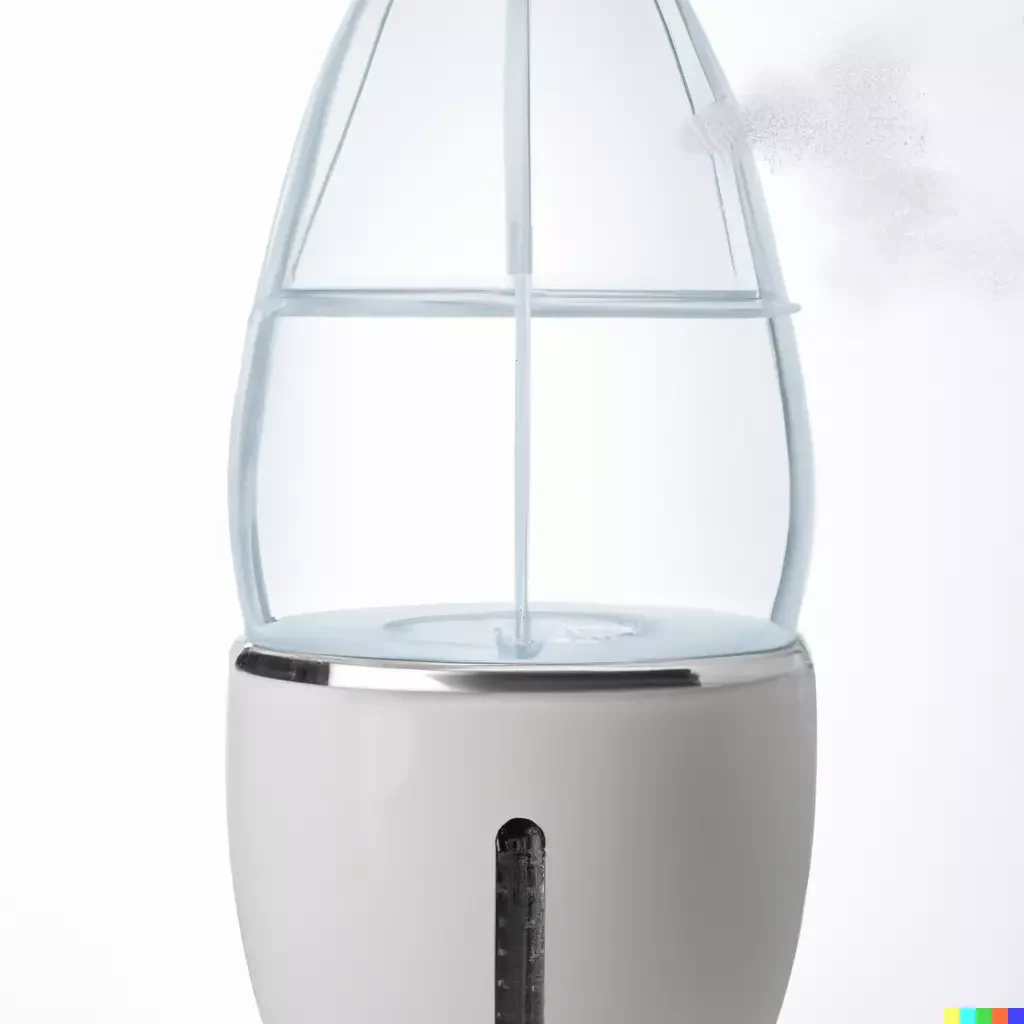A humidifier can cause mold if the humidity level is too high. Proper maintenance and regulation of humidity can prevent mold growth.
Keeping indoor humidity levels in check is crucial when using a humidifier to ensure a healthy living environment. Excess moisture from an overused or improperly maintained unit can lead to mold and mildew development on surfaces and in the air.
Mold thrives in damp, warm conditions, and a humidifier can inadvertently create the perfect breeding ground if not closely monitored. It’s essential to use a humidifier with a built-in hygrometer or pair it with a separate one to keep an eye on the humidity levels. Regular cleaning and adhering to the manufacturer’s guidelines are also key steps in preventing the occurrence of mold in your home or office space due to humidifier use.
Can Humidifiers Encourage Mold Growth?
Introducing moisture into our homes with a humidifier can indeed create an oasis, particularly during dry seasons, but an important question often emerges: Can a humidifier cause mold? The concern is legitimate, as mold thrives in moist environments, and balancing indoor humidity is critical in the fight against mold. Let’s delve into the intricacies of this balance to ensure your quest for comfort doesn’t become a breeding ground for unwanted fungal guests.
Understanding The Relationship Between Humidity And Mold
Mold is not just unsightly; it’s a sign of excess moisture in your environment. Mold spores float through the air continually, seeking the ideal conditions to settle and reproduce, namely warmth, food sources like paper or fabric, and most importantly, moisture. High humidity levels provide the perfect habitat for these spores to take root and flourish, which is why monitoring indoor humidity becomes paramount.
Optimal Humidity Levels For Preventing Mold
To prevent mold, indoor humidity levels should be kept between 30-50%. This range is low enough to deter mold growth, yet high enough to provide comfort and avoid the issues of overly dry air, such as irritated respiratory tracts. A hygrometer, a simple instrument to measure humidity, can be a valuable tool in keeping a vigilant eye on your home’s humidity levels.
Circumstances When Humidifiers May Contribute To Mold Formation
While humidifiers serve a beneficial purpose, certain conditions can transform them into unwitting accomplices of mold proliferation:
- Overuse: Running a humidifier constantly can cause humidity to soar well above the recommended levels, creating an ideal mold-growing environment.
- Lack of Maintenance: Neglecting regular cleaning of the humidifier can lead to mold and bacteria buildup within the unit itself, which then gets dispersed into the air.
- Improper Placement: Placing a humidifier too close to walls or fabrics can lead to localized dampness, where mold can establish its foothold.
It’s essential to strike a balance and ensure your humidifier is maintained properly, used in moderation, and placed strategically to maintain optimal moisture levels without inviting mold.

Credit: issuu.com
Spotting Signs Of Mold Around Humidifiers
Humidifiers are essential for maintaining comfort in homes with dry climates or during colder months. However, without proper maintenance, these devices can become a breeding ground for mold – an unwelcome guest with potential health risks. Spotting early signs of mold around your humidifier can help prevent its spread and maintain a healthy living environment. Let’s uncover the most telling indicators of mold presence in areas where humidifiers operate.
Visual Indications Of Mold Near Humidifier Environments
Identifying mold begins with a vigilant eye. Here are some visual indications you should look for:
- Discoloration: Unusual spots on surfaces near your humidifier might be the first clue. Mold can appear in various colors, like black, green, or white.
- Patterned Growth: Mold often forms in clusters with a speckled pattern along walls, ceilings, or on the humidifier itself.
- Surface Damage: Warped or peeling paint or wallpaper can suggest hidden mold growing beneath the surface due to excessive moisture.
Smell And Health Symptoms Related To Mold Exposure
Mold’s presence isn’t just seen; it’s often smelled and felt in the form of health symptoms. Pay attention to:
- Musty Odor: A persistent earthy or musty smell around your humidifier can be a telling sign. Mold emits a noticeable odor, especially as it proliferates.
- Respiratory Issues: Experiencing a sudden onset of allergy-like symptoms such as sneezing, coughing, or itchy eyes may be linked to mold exposure from your humidifier.
- Worsening Asthma: For those with asthma, an increase in attacks or difficulty in breathing could signify mold is affecting air quality.
When To Suspect Your Humidifier Is The Source
It’s crucial to recognize when your humidifier might be the mold culprit. Consider the following factors:
- Consistent Use Without Cleaning: Not cleaning your humidifier regularly can lead to mold growth.
- Pooled Water: If water sits in the humidifier’s reservoir for extended periods, it may become a stagnant zone ripe for mold.
- Humidity Levels: Humidity exceeding 60% can encourage mold growth. Use a hygrometer to monitor indoor humidity levels.
Regular inspections, cleanings, and monitoring are your best defense against mold. Act immediately upon spotting any signs to protect your health and home.
Clean Humidifier Protocols To Combat Mold
Keeping a home’s air properly moisturized with a humidifier can make a significant difference in comfort, particularly during harsh winter months or in arid climates. However, the benefits of this added moisture can be counteracted by a hidden menace: mold growth inside humidifiers. Mold in humidifiers can be a serious issue, causing both health problems and unpleasant odors in a home. To tackle this potential problem, certain clean humidifier protocols must be followed diligently.
Regular Cleaning Schedules For Different Types Of Humidifiers
Cleaning frequency can vary greatly depending on the type of humidifier. For instance:
- Central humidifiers, built into home heating and air conditioning systems, require at least an annual inspection and cleaning, ideally by a professional.
- Ultrasonic and impeller humidifiers need cleaning at least once a week to prevent mold spores from being expelled into the air.
- Evaporators and steam vaporizers also require weekly cleaning due to water exposure and potential mineral buildup.
Clean storage is also vital. Empty the tank, dry the interior, and change any wicking filters as recommended when the humidifier is not in use.
Best Practices In Water And Filter Changes
Regularly changing the water in your humidifier is crucial. Standing water can become a breeding ground for microorganisms, which can then be released into the air. Adhere to the following best practices:
- Use distilled or demineralized water. Tap water contains minerals that can create deposits in your humidifier that promote bacterial growth.
- Change water daily. Empty tanks before refilling to ensure water freshness.
- Clean filters according to the manufacturer’s direction. Filters can trap pollutants and microorganisms, which are then redistributed if not cleaned or replaced regularly.
Importance Of Manufacturer’s Guidelines To Curb Mold Risk
Adhering to the manufacturer’s guidelines cannot be overstated when it comes to preventing mold growth. Each humidifier model might have specific maintenance requirements, including:
- Specific cleaning solutions and techniques.
- The frequency of cleaning and filter replacements.
- Instructions on proper unit storage.
Always consult the manual for optimal care and follow the guidelines to ensure safe, effective operations and to maintain the warranty.
Selecting Mold-resistant Humidifiers And Accessories
Maintaining a healthy humidity level in your home is a balancing act. While humidifiers can help in dry climates or during cold months, they can also inadvertently become breeding grounds for mold. Choosing the right mold-resistant humidifier and accessories is crucial to reap the benefits of humidity without risking mold growth. Let’s explore what to look for in terms of materials and features that help prevent the occurrence of mold in humidifiers.
Materials That Resist Mold Growth
The battle against mold begins with the construction of the humidifier. Materials that resist water retention and have a naturally antibacterial surface can significantly reduce mold risks. Here are a few options to consider:
- Stainless Steel: Resists moisture and does not allow mold to easily adhere or grow.
- Plastic with Antimicrobial Additives: Some plastics are enhanced with antimicrobial substances that inhibit the growth of mold and bacteria.
- UV-Light: While not a material, units equipped with UV-light technology can kill mold spores and bacteria in the water tank.
Features To Look For In A Humidifier To Prevent Mold
Beyond materials, certain features can drastically reduce the need for frequent cleaning and limit the potential for mold growth. Ensure your humidifier includes these mold-preventative features:
| Feature | Description | Benefit |
|---|---|---|
| Removable Water Tanks | Tanks that can be detached and cleaned separately. | Eases cleaning and drying, reducing mold chances. |
| Water Filters | Filters to purify water before it’s used. | Less mineral build-up means less environment for mold. |
| Automatic Shutoff | Turns off when desired humidity is reached. | Prevents excessive moisture, a key factor for mold. |
An additional feature to consider is the ease of disassembly. The simpler it is to take apart, the more likely it will be thoroughly cleaned, ensuring mold has no safe harbors. Pair these features with regular maintenance, and you’re setting up a healthy, mold-resistant environment in your home.
Balancing Humidity And Health: Expert Advice
An optimal humidity level in your home is essential for comfort and health. Too much humidity, however, can lead to the unwanted growth of mold and mildew, which are hazardous to health and can damage your home. It’s crucial to maintain the perfect balance—it’s where a humidifier can be beneficial if used correctly. Understanding how to manage your humidifier to prevent the proliferation of mold is key to creating a healthy living space. Let’s explore some expert advice on achieving and maintaining that balance.
Recommendations From Health And Building Professionals
Maintaining the proper humidity levels in your home is essential according to health and building experts. They underscore the importance of:
- Setting your humidifier to keep indoor humidity between 30% and 50%.
- Cleaning your humidifier regularly to prevent bacteria and mold spores from spreading.
- Ensuring proper ventilation, especially in areas like bathrooms and kitchens, to reduce excess moisture.
- Addressing leaks and dampness to prevent mold growth from the outset.
Utilizing Hygrometers For Moisture Level Monitoring
To prevent mold, it’s important to monitor the moisture in your environment. A hygrometer is an invaluable tool for this. Follow these steps:
- Place a hygrometer in the room where you use a humidifier.
- Check the reading regularly to ensure that the humidity levels stay within the recommended range.
- Adjust your humidifier settings accordingly to avoid excess humidity.
Keeping tabs on humidity levels helps you react quickly if levels creep too high, which is a risk factor for mold growth.
Final Tips On Keeping A Mold-free Environment With A Humidifier
Following these final tips can help safeguard your home against mold while using a humidifier:
| Tip | Action |
|---|---|
| Regular Maintenance | Empty, clean, and dry the humidifier’s reservoir daily. |
| Correct Usage | Only use distilled or demineralized water to reduce mineral buildup and microbial growth. |
| Location Choice | Place the humidifier in a well-ventilated area and not directly on carpets or wooden surfaces. |
Please remember, consistent monitoring and good practices are the pillars of using a humidifier without encouraging mold growth. By following these expert guidelines, you can enjoy the health benefits of a humidifier without compromising the air quality of your home.
Frequently Asked Questions Of Can A Humidifier Cause Mold
Can Humidifiers Lead To Mold Growth In Homes?
Humidifiers can contribute to mold growth when humidity levels are not properly maintained. Mold thrives in moist environments, and humidifiers that raise the indoor humidity above 60% can create conditions favorable for mold to develop, especially if the area is not well-ventilated.
How Do I Prevent Mold When Using A Humidifier?
To prevent mold while using a humidifier, maintain indoor humidity levels between 30-50%. Regularly clean and dry the humidifier to prevent mold spores from proliferating. Also, use distilled or demineralized water to minimize potential mold growth within the device.
What Are The Signs Of Mold From A Humidifier?
Signs of mold from a humidifier include musty odors, visible mold spots near the device, and increased allergy symptoms among house occupants. If you notice these signs, inspect and clean your humidifier, and check your indoor humidity levels.
Will Mold From A Humidifier Make Me Sick?
Exposure to mold from a humidifier can potentially cause health issues, especially for individuals with mold allergies or respiratory conditions. Symptoms may include coughing, sneezing, itchy eyes, and other allergic reactions. If you suspect mold-related sickness, consult a healthcare provider.
Conclusion
To sum up, maintaining your humidifier is key to avoiding mold growth. Regular cleaning and monitoring of humidity levels are essential. Ensure that your device isn’t contributing to damp conditions which mold thrives in. Remember, a well-cared-for humidifier promotes health, not mold.





